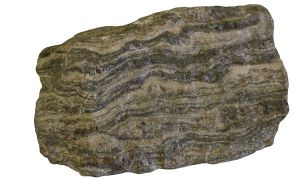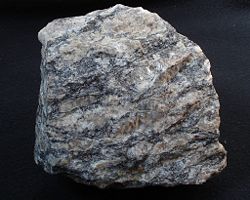Gneiss
Gneiss is a common and widely distributed type of rock formed by high-grade regional metamorphic processes from preexisting formations that were originally either igneous or sedimentary rocks. Gneissic rocks are usually medium to coarse foliated (aligned by directed pressure) and largely recrystallized but do not carry large quantities of micas, chlorite or other platy minerals.
Gneisses that are metamorphosed igneous rocks or their equivalent are termed granite gneisses, diorite gneisses, and so forth. Depending on their composition, they may also be called garnet gneiss, biotite gneiss, albite gneiss, and so forth. Orthogneiss designates a gneiss derived from an igneous rock, and paragneiss is one from a sedimentary rock. Gneissose is used to describe rocks with properties similar to gneiss.
Gneiss resembles granite, except that the minerals are arranged into bands. Sometimes it is difficult to tell the difference between gneiss and a schist because some gneiss appears to have more mica than it really does. This is especially true with mica-rich parting planes. If a rock shows minerals occurring in distinct bands, it is probably gneiss.
The word "gneiss" is from an old Saxon mining term that seems to have meant decayed, rotten, or possibly worthless material.
The Acasta Gneiss is the oldest known crustal rock in the world.
Augen gneiss
Augen gneiss is a coarse-grained gneiss, interpreted as resulting from metamorphism of granite, which contains characteristic elliptic or lenticular shear bound feldspar porphyroclasts, normally microcline, within the layering of the quartz, biotite and magnetite bands.
Etymology: from the German augen, meaning "eyes".
See also
ReferencesISBN links support NWE through referral fees
- Blatt, Harvey, and Robert J. Tracy. 1995. Petrology: Igneous, Sedimentary, and Metamorphic, 2nd ed. New York: W.H. Freeman. ISBN 0716724383.
- Farndon, John. 2006. The Practical Encyclopedia of Rocks & Minerals: How to Find, Identify, Collect and Maintain the World's best Specimens, with over 1000 Photographs and Artworks. London: Lorenz Books. ISBN 0754815412.
- Pellant, Chris. 2002. Rocks and Minerals. Smithsonian Handbooks. New York: Dorling Kindersley. ISBN 0789491060.
- Shaffer, Paul R., Herbert S. Zim, and Raymond Perlman. 2001. Rocks, Gems and Minerals. Rev. ed. New York: St. Martin's Press. ISBN 1582381321.
Credits
New World Encyclopedia writers and editors rewrote and completed the Wikipedia article in accordance with New World Encyclopedia standards. This article abides by terms of the Creative Commons CC-by-sa 3.0 License (CC-by-sa), which may be used and disseminated with proper attribution. Credit is due under the terms of this license that can reference both the New World Encyclopedia contributors and the selfless volunteer contributors of the Wikimedia Foundation. To cite this article click here for a list of acceptable citing formats.The history of earlier contributions by wikipedians is accessible to researchers here:
The history of this article since it was imported to New World Encyclopedia:
Note: Some restrictions may apply to use of individual images which are separately licensed.

